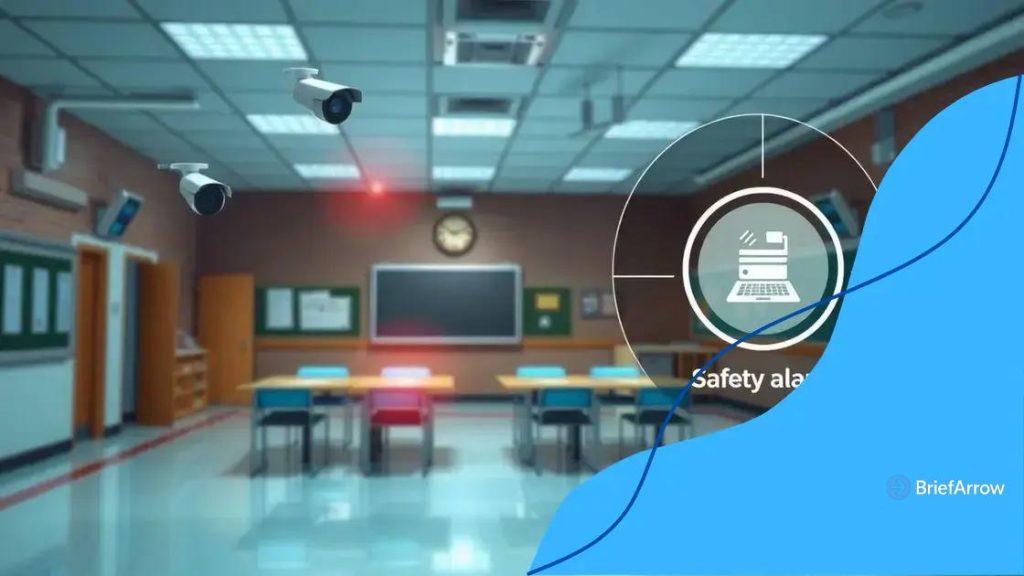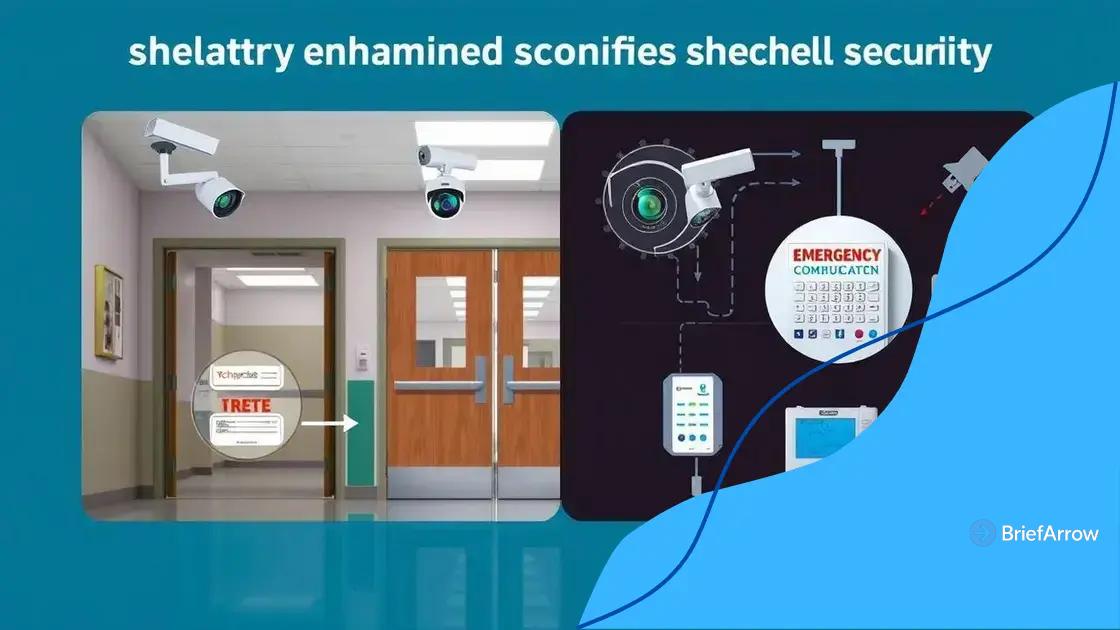Funding for school safety technology increased significantly

Anúncios
Funding for school safety technology increased significantly, allowing schools to enhance security through advanced systems like surveillance, access control, and emergency communication, ultimately creating safer learning environments for students and staff.
Funding for school safety technology increased in recent years, reflecting a growing recognition of its importance. Are we doing enough to protect our children? In this article, we’ll delve into how this funding is making a difference.
Anúncios
The importance of school safety technology
The importance of school safety technology cannot be overstated. As we navigate a world where safety concerns are ever-present, schools must adopt innovative solutions to protect students and staff. By investing in advanced safety measures, educational institutions can create a secure learning environment.
Benefits of Safety Technology
Implementing school safety technology offers numerous advantages. For instance, it enhances communication, allowing for quick responses to emergencies. Furthermore, technology can monitor premises, alerting authorities to any suspicious activity.
- Improved communication channels during emergencies
- Real-time surveillance to deter potential threats
- Automated alerts to law enforcement and administrators
Moreover, these technologies often include systems like access control, which restrict unauthorized people from entering school grounds. This added layer of security is crucial for maintaining safety.
Anúncios
Types of Safety Technologies
There are several types of safety technologies that schools can implement.
- Security cameras for constant monitoring
- Emergency communication systems to notify staff and students
- Access control systems to limit building entry
In addition to these, enhanced emergency response systems ensure schools can effectively manage crises. By utilizing these tools, schools enhance their readiness to face unforeseen challenges.
Every school must prioritize implementing these safety technologies. By doing so, they not only protect their students but also foster a culture of safety and preparedness throughout the educational community. Ultimately, the goal is to create an environment where learning can flourish without fear or disruption.
Recent trends in funding for safety measures
Recent trends in funding for safety measures within schools show a significant shift towards prioritizing student and staff security. As safety concerns rise, schools are turning to various funding sources to enhance their safety protocols.
Increased Government Funding
Governments are recognizing the importance of investing in school safety. Many states have increased their budgets specifically for safety technology, aiming to protect educational environments effectively. This funding can be used for various initiatives aimed at improving security.
- Grants for purchasing surveillance equipment
- Funding for training staff on emergency procedures
- Support for implementing communication systems
As a result, schools can access vital resources needed to enhance their safety infrastructure significantly.
Community Partnerships
Another trend is the rise of community partnerships. Schools are collaborating with local businesses and organizations to secure additional funding. These partnerships often lead to creative solutions and shared resources, ultimately benefiting the school environment.
For instance, local companies may provide funding for safety drills or contribute to installing new security systems. This collaborative approach fosters a sense of community involvement in enhancing student safety.
Additionally, many schools are exploring federal funding options. Programs designed to help improve school security are becoming more accessible. By tapping into these resources, schools can implement innovative safety measures.
Focus on Mental Health Resources
Funding trends also reflect a growing understanding of the link between safety and mental health. Schools are increasingly investing in mental health resources as part of their safety measures. This approach addresses the root causes of safety concerns.
- Hiring more counselors and mental health professionals
- Implementing programs that promote student well-being
- Training staff to recognize signs of distress
By integrating mental health support, schools are creating a more comprehensive approach to safety that nurtures a positive learning environment.
How technology enhances school security

Technology plays a vital role in how schools enhance their security measures. By utilizing advanced tools, schools create a safer environment for students and staff. Various technologies help improve safety, offering innovative solutions to age-old problems.
Surveillance Systems
One of the most effective measures is the installation of surveillance systems. Security cameras provide constant monitoring and can deter potential threats. These systems allow school officials to oversee activities in real-time, ensuring quick responses to any unusual behavior.
- 24/7 monitoring of school grounds
- Recorded footage for evidence in investigations
- Improved safety for students and staff
Alongside cameras, there are other technologies that complement surveillance systems.
Access Control
Access control systems are essential in maintaining school security. These systems limit entry points and monitor who enters the building. Keycard systems or biometric scanners enhance safety by ensuring only authorized individuals can access school facilities.
They help prevent unauthorized access, creating a secure environment. Moreover, these systems can track visitor entry, providing valuable data for school administration.
Emergency Communication Systems
Having a robust emergency communication system is crucial for keeping students and staff informed. These systems allow for immediate notifications during emergencies, such as lockdowns or evacuations.
- Instant alerts to staff and students
- Integration with mobile apps for real-time updates
- Facilitating coordinated responses with local authorities
With reliable communication, schools can manage crises more effectively, ensuring everyone is aware of safety protocols.
Data Analytics for Risk Assessment
Another way technology enhances school security is through data analytics. Schools can analyze patterns in incidents and identify vulnerabilities. This information is vital for making informed decisions on where to allocate resources and improve safety measures.
By leveraging technology, schools can create a culture of safety and preparedness, allowing students to feel secure and focus on their education.
Challenges in implementing safety technology
Implementing safety technology in schools is vital, but it also comes with challenges. Schools face numerous obstacles that can hinder the effectiveness of these technologies. Understanding these challenges can help institutions develop better strategies for overcoming them.
Budget Constraints
One major challenge is the issue of budget constraints. Many schools operate on tight budgets, making it difficult to allocate funds for advanced security technologies. Expenses may include purchasing equipment, installation costs, and ongoing maintenance. These financial limits can restrict schools from investing in the latest safety solutions, which are essential for protecting students.
- High initial costs for technology purchase
- Ongoing maintenance and updates required
- Limited resources for training staff
This financial barrier often forces schools to compromise on the level of safety they can provide.
Staff Training
Another significant hurdle is the need for thorough staff training. Implementing new safety technologies requires that staff members know how to use them effectively. Without proper training, the risk is that technology may not be utilized correctly during critical situations.
Training sessions can be time-consuming and may require additional funds. Furthermore, it is essential that all staff feel confident in using safety technologies to ensure a quick response in emergencies.
Resistance to Change
Resistance to change can also pose challenges when introducing new safety technologies. Some staff may be reluctant to adopt new systems, preferring the old ways of doing things. This mindset can slow down the implementation process and reduce the effectiveness of new technology.
Additionally, students and parents might also need time to adjust to these changes. Communication is essential to help everyone understand the benefits of these new safety measures.
Technological Difficulties
Technological difficulties can arise during the integration of new systems. Compatibility between older systems and new technologies might pose challenges. Schools may encounter issues like system failures or malfunctions that can disrupt operations.
- Integration of old and new technologies
- Technical support needs can be ongoing
- Cybersecurity threats to sensitive information
Addressing these hurdles requires planning, commitment, and ongoing evaluation of technology effectiveness. Schools must approach the implementation of safety technologies with a comprehensive strategy to maximize their potential benefits.
Future outlook on school safety technology funding
The future of school safety technology funding looks promising as awareness of the need for secure learning environments continues to grow. Schools and communities are recognizing that investing in safety technology is crucial for protecting students and staff alike. The ongoing dialogue about safety has prompted various stakeholders to prioritize funding.
Increased Government Support
Governments are expected to increase their support for school safety initiatives. As incidents of violence and emergencies have escalated, policymakers are more focused on allocating resources specifically for safety technologies. This trend may lead to the creation of new funding programs dedicated solely to enhancing school safety.
- Potential for larger grants from federal and state levels
- More targeted funding for mental health resources
- Increased collaboration among educational institutions and government bodies
Such support can enable schools to implement cutting-edge technologies, ensuring that security measures continually evolve to meet new challenges.
Innovation in Safety Technologies
The advent of advanced technologies also shapes the funding landscape. As innovations emerge, schools will need to adapt and invest in the latest advancements to maintain security. Technologies like AI-powered surveillance systems or advanced access control methods can offer improved safety.
Funding bodies will likely recognize the benefits of these innovations, leading to more investment opportunities. Schools that seek to incorporate these technologies may find new avenues for funding, making cutting-edge security more accessible.
Community Engagement and Support
Community involvement will play a critical role in securing funding for safety technologies. Engaging parents, local businesses, and community organizations can lead to partnerships that enhance school safety initiatives. When communities work together, they can create a stronger support system.
- Collaborative fundraising events
- Donation drives for safety equipment
- Local businesses providing grants for technology upgrades
This cooperative effort will not only increase funding but also promote a culture of safety and awareness among all community members.
Sustainable Funding Models
Future funding models must also focus on sustainability. Schools need reliable and ongoing funding to maintain safety technologies effectively. This means looking for diverse funding sources, such as public-private partnerships, grants, and continuous fundraising initiatives.
By establishing sustainable funding models, schools can ensure that safety technologies are updated regularly, fostering an environment where students can learn without fear.
FAQ – Frequently Asked Questions about School Safety Technology Funding
Why is funding for school safety technology important?
Funding for school safety technology is crucial as it helps create secure environments for students and staff, allowing them to focus on education without fear.
What are some common sources of funding for school safety initiatives?
Common sources include government grants, local community partnerships, and fundraising events aimed at enhancing school security.
What types of safety technologies are schools investing in?
Schools are investing in surveillance systems, access control technologies, emergency communication systems, and mental health resources to improve overall safety.
How can communities support school safety funding efforts?
Communities can support funding efforts by organizing fundraising events, providing local business grants, and collaborating on initiatives that promote student and staff safety.